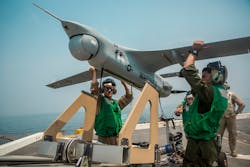Navy orders 24 unmanned aerial vehicles (UAVs) and 62 sensor payloads in $32 million deal to Boeing Insitu
PATUXENT RIVER NAS, Md. – U.S. Navy unmanned aerial vehicle (UAV) experts are spending $32 million on small unmanned aircraft and UAV sensor payloads for persistent surveillance for the Navy, U.S. Marine Corps., and U.S. allies.
Officials of the Naval Air Systems Command at Patuxent River Naval Air Station, Md., announced a $32 million order late last month to Boeing Insitu Inc. in Bingen, Wash., for four RQ-21A Blackjacks, 20 ScanEagles, 62 ScanEagle payloads and turrets, as well as support equipment and spare parts.
The Boeing Insitu ScanEagle UAV is 5.1 feet long with a 5.6-foot wingspan. It weighs as much as 48.5 pounds and can carry a 7.5-pound sensor payload. The UAV can fly for more than 24 hours at altitudes as high as 19.500 feet, and at speeds to 80 knots.
The ScanEagle UAV can fly on gasoline or heavy fuels like jet fuel, diesel, or kerosine. It provides persistent surveillance and reconnaissance imagery on land or at sea at lower costs than other surveillance methods for military and agriculture missions.
Related: Sensor payloads for unmanned vehicles
ScanEagle can carry a sensor payload consisting of visible-light camera, medium-wave infrared imager, or both integrated in one turret. The UAV also has an analog digitally encrypted video data links, as well as encrypted or unencrypted command-and-control data links.
The UAV can be launched autonomously and uses a no-nets recovery system that recovers with its wing tip on a rope that hangs from a boom.
The Boeing Insitu RQ-21 is a twin-boom, single-engine, monoplane UAV for surveillance and reconnaissance. It an be launched and recovered on land or at sea without runways, using a pneumatic launcher and net-type recovery system. The contract was announced on 18 Dec. 2014.
The 81-pound Blackjack -- so-named in September 2013 -- is eight feet long with a 16-foot wingspan designed to carry multi-sensor payloads in large pod below its nose. The UAV can fly as fast as 104 miles per hour, cruises at 63 miles per hour, can fly as long as 24 hours, and can fly as high as 19,500 feet. It is a version of the Insitu Integrator UAV.
The multi-mission RQ-21A Blackjack's open-architecture payload bays can be customized with visible-light and infrared cameras, communications and other tools to give warfighters on the forward edge of battle situational awareness information.
It can integrate new payloads quickly, offers roll-on, roll-off capability to move the system quickly from ship to shore, and aboard cargo aircraft. The UAV can carry sensor payloads as heavy as 39 pounds.
The Blackjack's standard sensor payload consists of a visible-light imager, mid-wave infrared imager, laser rangefinder, infrared marker, communications, and Automatic Identification System (AIS).
The RQ-21A will provide persistent maritime and land-based tactical reconnaissance, surveillance, and target acquisition (RSTA) data collection and dissemination capabilities to the warfighter.
For the Marine corps it will provide the marine expeditionary force, divisions, and regiments with a dedicated intelligence, surveillance, and reconnaissance (ISR) system that sends information to the tactical commander in real time.
For the Navy the Blackjack will provide persistent RSTA information to Navy ships, Marine Corps land forces, Navy expeditionary combat command forces and Navy special warfare units.
On this order Boeing Insitu will do the work in Bingen, Wash.; and locations outside the U.S., and should be finished by June 2026. For more information contact Boeing Insitu online at www.insitu.com, or Naval Air Systems Command at www.navair.navy.mil.
